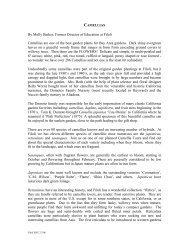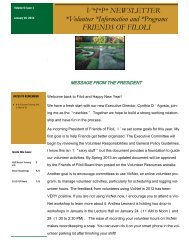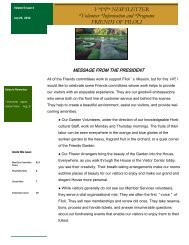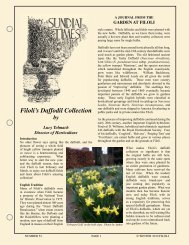You also want an ePaper? Increase the reach of your titles
YUMPU automatically turns print PDFs into web optimized ePapers that Google loves.
CAMELLIA RENOVATION<br />
AT FILOLI<br />
by<br />
Paul Cady<br />
The camellia collection at <strong>Filoli</strong> is an extensive<br />
and historic part of the garden. Of the more than<br />
100 species of camel lia worldwide, <strong>Filoli</strong> has<br />
nine species and hybrids; our largest collections<br />
are of Camellia japonica, C. sasanqua, and C.<br />
reticulata, with C. japonica cultivars being the<br />
best represented. Most of the camellias at <strong>Filoli</strong><br />
were planted by Mrs. Roth when she was in<br />
residence from the 1930s to the 1970s, mainly in<br />
the walled and woodland gardens. Camellias can<br />
also be found around the house, Garden Shop, and<br />
near the balustrades along the lawns. Camellias<br />
are in bloom from late October to May.<br />
Camellias at <strong>Filoli</strong> are pruned extensively every<br />
year to encourage flowering, remove dead wood,<br />
and maintain their size and shape. The goal of<br />
our pruning is to create a small tree or shrub with<br />
a uniform branch structure supporting a dense<br />
canopy, which will produce a wall of flowers when<br />
in bloom. Most of our camellias are shaped into<br />
specific forms, while others in less formal areas<br />
are allowed to expand and grow to their full sizes.<br />
This latter tactic was employed for many years<br />
in the walled and woodland gardens, resulting in<br />
large mature plants. Unfortunately, the eventual<br />
A JOURNAL FROM THE<br />
GARDEN AT FILOLI<br />
size of the camellias was not taken into account at<br />
planting. The result was overcrowding and a tall,<br />
arching canopy with few lower branches and large<br />
dimensions out of scale with the surrounding<br />
garden. Because camellias flower on previous<br />
year’s growth, most of the growth was at the top<br />
and the majority of the flowers were high off the<br />
ground where no one could see them.<br />
Due to overcrowding, inaccessibility of flowers,<br />
and general scale issues, the decision was made<br />
in 2008 to renovate the Camellia japonica and<br />
C. sasanqua shrubs in the walled and woodland<br />
gardens. Renovation is an accepted horticultural<br />
practice for reducing the size of camellias. Once a<br />
hard cut (renovation) is made, the dormant buds in<br />
the trunks have the ability to sprout and grow into<br />
new branches. At <strong>Filoli</strong> we do not renovate C.<br />
reticulata as we have found they do not respond<br />
as well, if at all, to hard renovation pruning.<br />
Before considering renovation, you should realize<br />
that pruning begets more pruning; once you<br />
begin pruning, the plant will have to be pruned<br />
every year to retrain and maintain the shape and<br />
size. Depending on the eventual size, the time<br />
commitment for pruning can be sizeable. If<br />
not properly trained after the initial renovation,<br />
the plant will produce copious amounts of<br />
weak, spindly growth, which is not conducive<br />
to creating an attractive, well maintained shrub<br />
and will probably leave you with a less desirable<br />
specimen. At <strong>Filoli</strong> we have committed ourselves<br />
to the necessary extra pruning time.<br />
Starting in 2008, and continuing to the present,<br />
the horticultural staff has been systematically<br />
renovating the overgrown specimens. In general,<br />
most plants have been brought down to a height<br />
between 6 and 10 feet, though some plants in<br />
the centers of beds have been left taller. All the<br />
sawing work was done with hand saws, rather<br />
than chain saws, to ensure clean, precise cuts.<br />
Plants were renovated into loose pyramidal<br />
shapes, with the top of the pyramid being as close<br />
to the middle of the plant as possible (see upper<br />
left photo, page 2). A strong horizontal branching<br />
pattern is ideal, and this was taken into account<br />
when pruning decisions were made. Sides were<br />
cut hard to maintain the structure of the pyramid,<br />
while leaving room for new growth to fill in and<br />
create the desired horizontal branching effect.<br />
Some vertical side growth was removed even if<br />
it created holes in the shrub, because removing<br />
vertical growth encourages bud sprouting from<br />
the inside of the plant, creating a better horizontal<br />
structure.<br />
Ideally, all renovation would be done in late<br />
winter in order to give the most time for new<br />
NUMBER 60 PAGE 1 © WINTER <strong>2013</strong> FILOLI
















